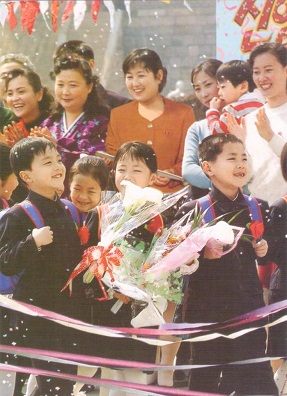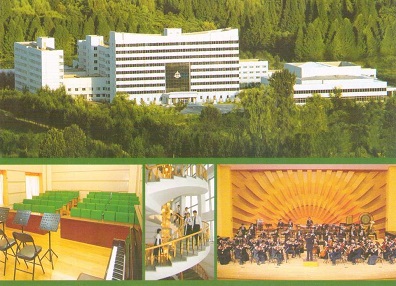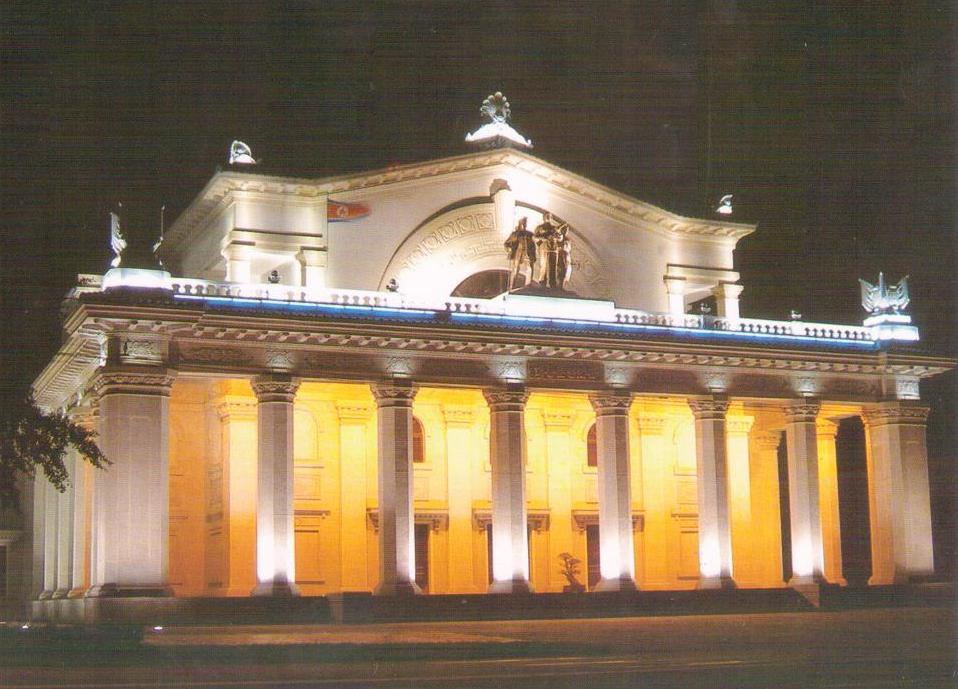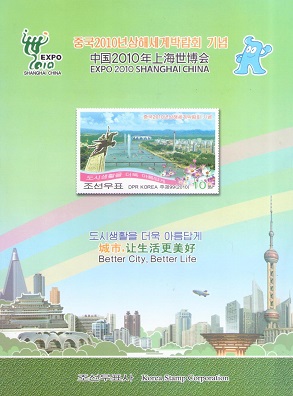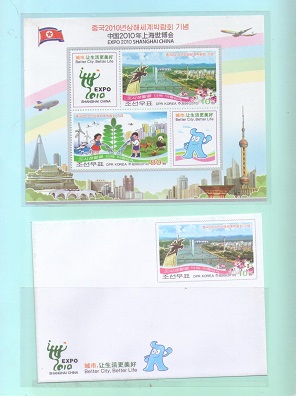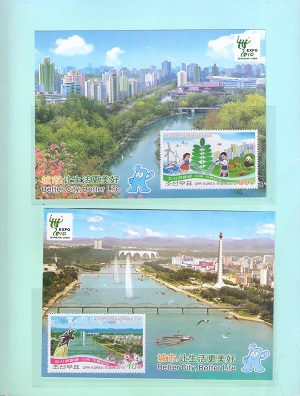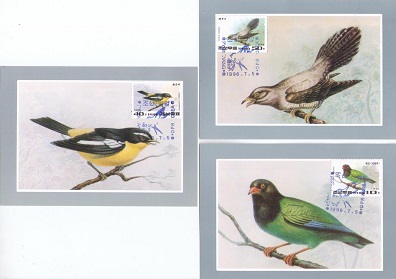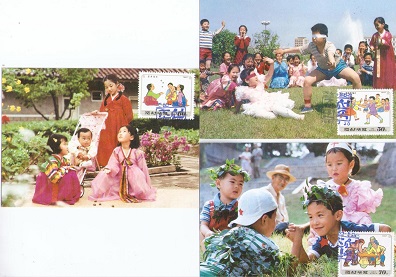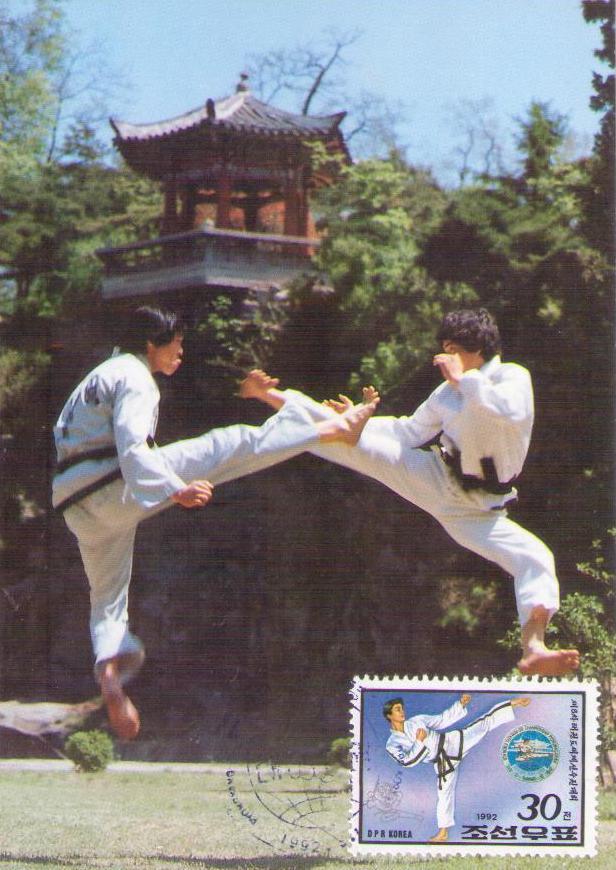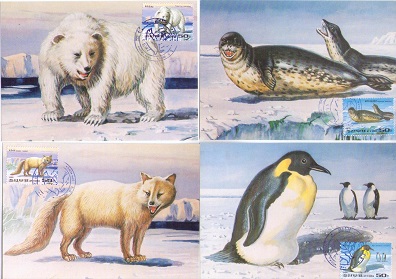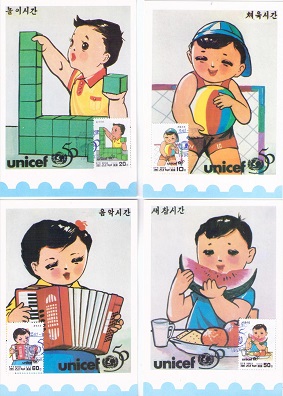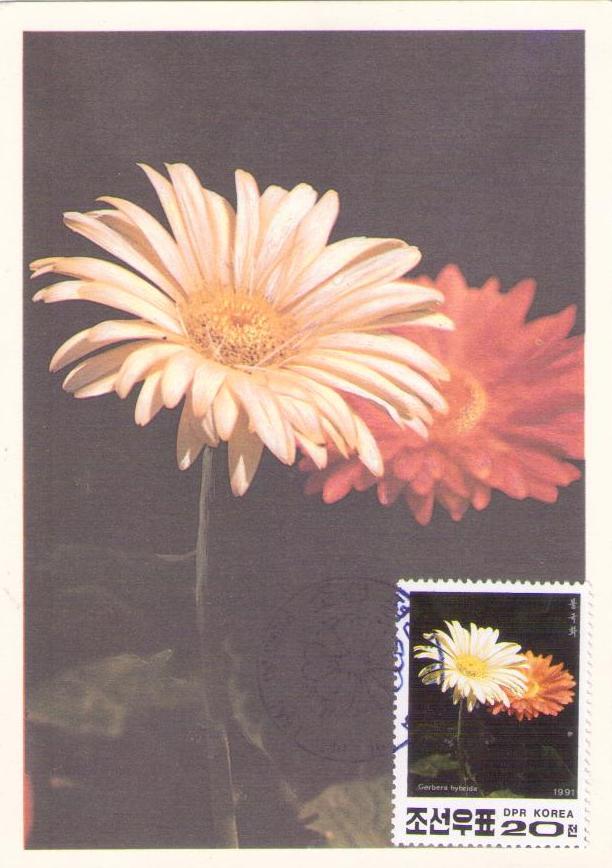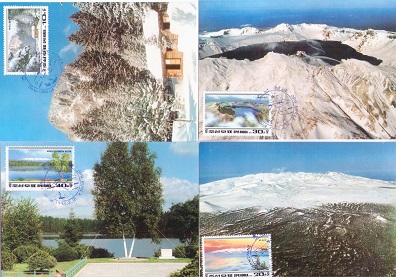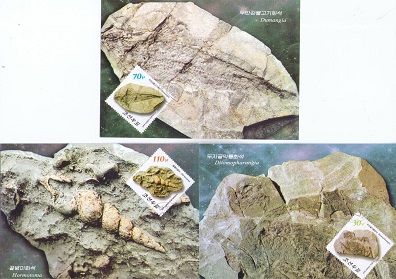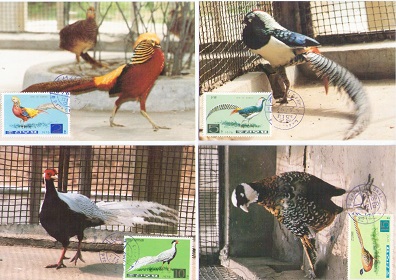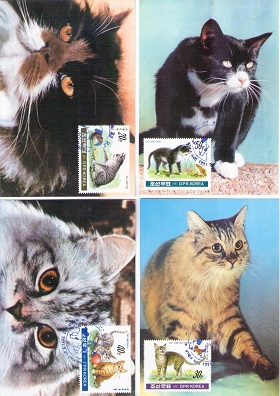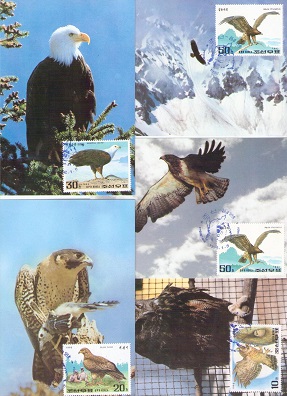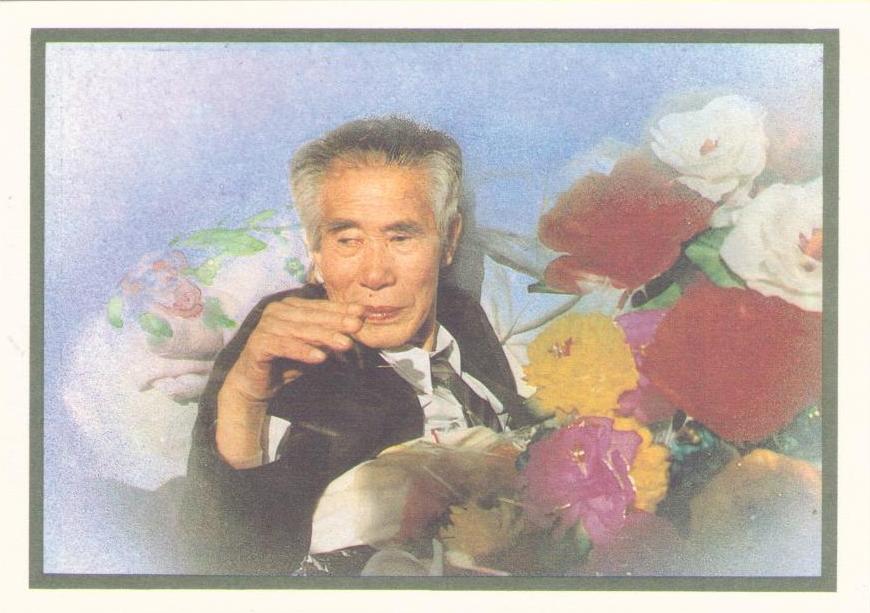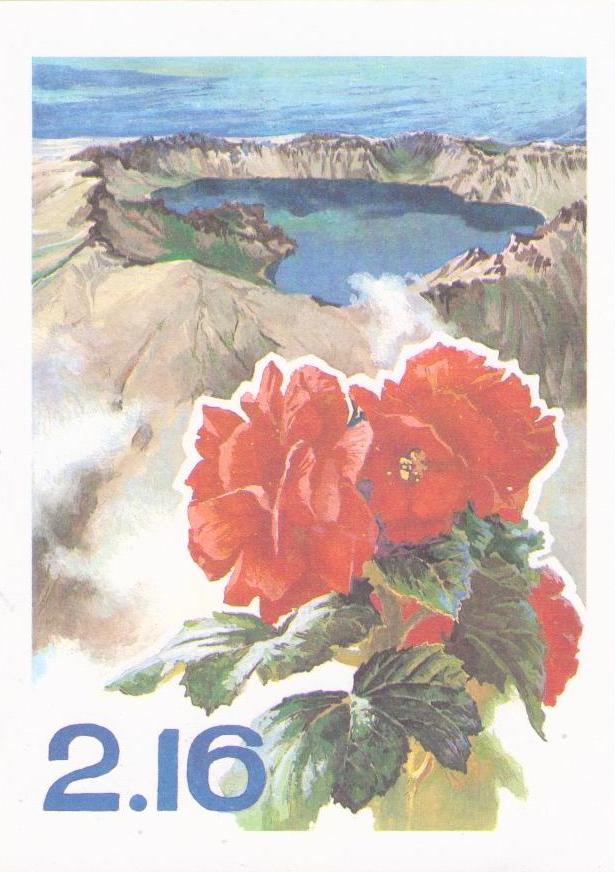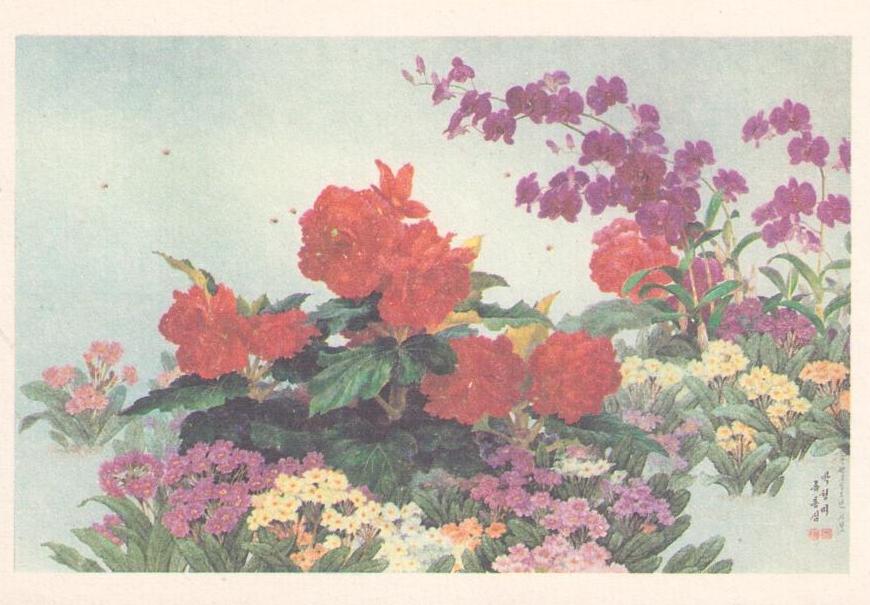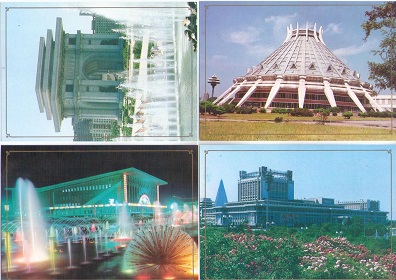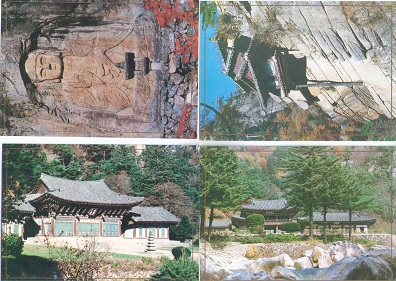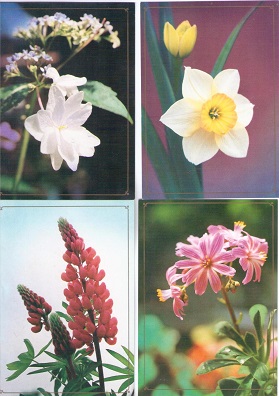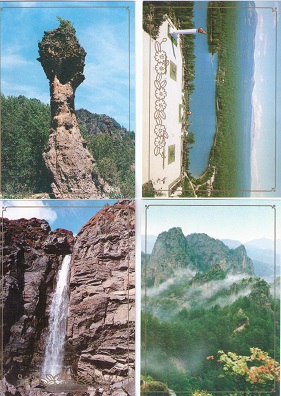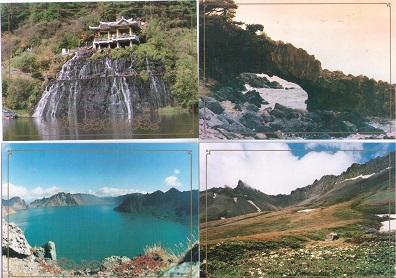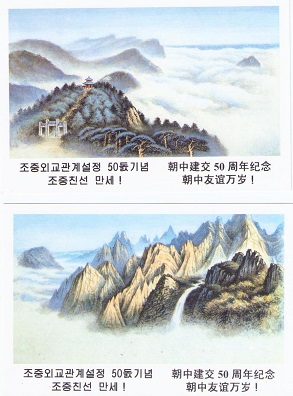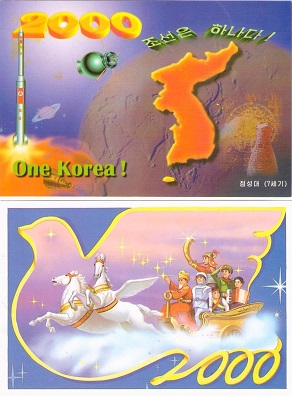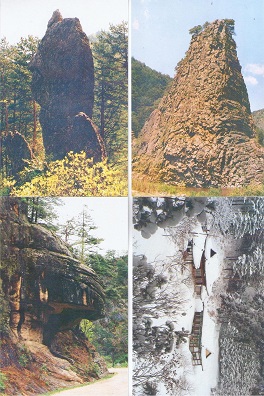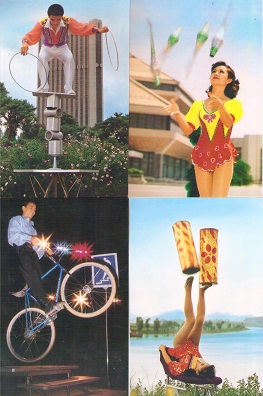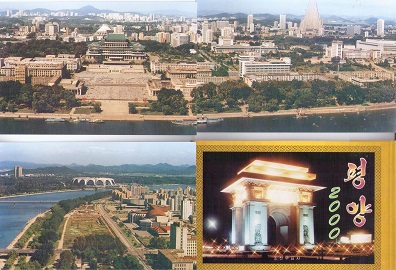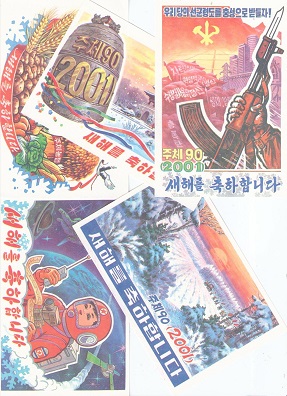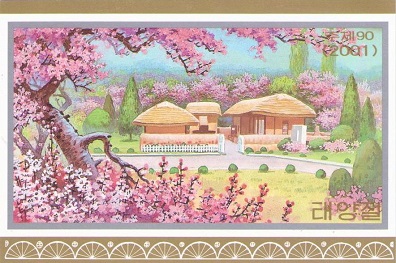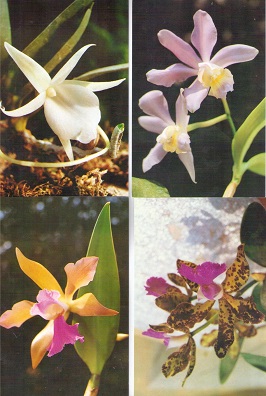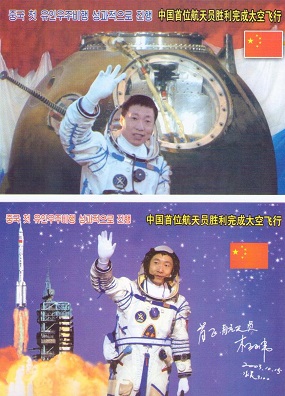-
Pyongyang, people
The Korean and Chinese captions may tell you more, on this unused card. Grade: 1
-
Pyongyang, orchestra
The card is unused and the captions are in Chinese and Korean. If we get the correct name of the building, we’ll adjust this entry. Grade: 1
-
Pyongyang, building at night
We don’t know the name of the building — yet. Unused card, captioned in Korean and Chinese. Grade: 1
-
Expo 2010 Shanghai China – front cover (set)
This is a folio measuring 8-1/4″ x 11-1/4″, and our scans 20312139A/B/C show you all but the outside back cover. The pre-printed stamped envelope and joint-issue stamp sheet are accesories to the two postcards, which show Pyongyang and Shanghai respectively. The huge stamps you see on the cards are real and not pre-printed, though not postmarked. The reverses just say “Postcard” in Korean. Grade: 1
-
Expo 2010 Shanghai China – inside front cover (set)
See 20312139A.
-
Expo 2010 Shanghai China – inside back cover (set)
See 20312139A.
-
Birds (set of 3) (Maximum Cards)
Set of three maximum cards from 1996, each captioned in Korean and with the scientific name of the respective bird: Ficedula zanthopygia, Eurystomus orientalis, Cuculus canorus. Pyongyang attribution on the back. Grades: 1
-
Folk games (set of 3) (Maximum Cards)
Set of three unused July 1997 maximum cards. Grades: 1
-
Taekwon-Do (Maximum Card)
Captioned in Korean and also in western lettering (can’t really call it “English” as it’s just the name of the martial art), this Maximum Card was issued in 1992 and has Pyongyang attribution. Grade: 1
-
Arctic and Antarctic Animals (set of 4) (Maximum Cards)
A set of four unused Maximum cards from 1996, and like many others from DPRK they are captioned in Korean and with scientific names: Hydrurga leptonyx, Apt enodytes forsteri, Alopex lagopus, and Thalarctos maritimus. (That is as they are, we’ve not verified them.) Please note that on these as well as other sets, there may be some postmark ink transfer on the reverses when cards were stacked at source. This is not a defect. Reference numbers 7-605105. Grades: 1
-
UNICEF (set of 4) (Maximum Cards)
From 1996 — a busy year in the annals of DPRK philately — this set of four maximum cards, with Pyongyang attribution in Roman lettering on the reverses. Grade: 1
-
Gerbera hybrida (Maximum Card)
Basically, a daisy. Wikipedia says, in substance: Gerbera is widely used as a decorative garden plant or as cut flowers. The domesticated cultivars are mostly a result of a cross between Gerbera jamesonii and another South African species Gerbera viridifolia. The cross is known as Gerbera hybrida. The caption is only in Korean, and translates as “fire mums”. Pyongyang attribution. Grade: 1
-
Pterophyllum eimekei (Maximum Card)
The scientific name for one of the angelfish; the unused card from 1991, with caption in Korean and “scientific”. Reference number 105296, and with Pyongyang attribution. Grade: 1
-
Mt. Paektu (set of 4) (Maximum Cards)
Issued in 1992, this set of four maximum cards is captioned in English and Korean, with the Pyongyang attribution. The four scenes include: Lake Chon on Mt. Paektu; Lake Samji; The native home in the secret camp in Mt. Paektu; and Mt. Paektu, the sacred mountain of the revolution. Grade: 1
-
Frogs (set of 6) (Maximum Cards)
Someone out there collects postcards of frogs and toads. We hope it’s you. Here’s an unused set of six Maximum Cards (four are in the scan) from 1992. Apart from Pyongyang attribution, the captions are only in Korean, but on the stamps, in tiny print, the scientific names appear. Series reference number 203106. Ribbit! Grades: 1
-
Fossils (set of 3) (Maximum Cards)
A set of three 2013 maximum cards, captioned with Korean and scientific names: Hormotoma, Ditomopharangia, and Dumangia. Unused. Grades: 1
-
Pheasants (set of 6) (Maximum Cards)
An older (1976) set of six maximum cards, Pyongyang attribution, and each card captioned in Korean and English. As information, because our scan only shows four of the six cards, the common names of all six are: White pheasant, Reeves’ pheasant, Silver pheasant, Lady Amherst pheasant, Golden pheasant, and Copper pheasant. Grade: 1
-
Cats (set of 5) (Maximum Cards)
Four of five cards from this 1991 set of maximum cards appear in the scan. They all have Pyongyang attribution on the back, and captions in Korean and English are identical: 고양이 (cat). It’s the stamps that go further: usually cat and something else, such as rat, or ball, or frog. Odd. Nice. Grade: 1
-
Birds of Prey (set of 5) (Maximum Cards)
DPRK sets can be confusing, and it takes a bit of sleuthing to figure out which cards go together. We think we have this one right, based on stamp and font design. Issued in 1992, five maximum cards, each with Korean and scientific name of the respective bird, and Pyongyang attribution. Grade: 1
-
Ri In-mo
Unused, completely “domestic” card with pre-printed postage and captioned entirely in Korean. Ri In-mo (1917-2007) was in prison in South Korea for 34 years before being repatriated to DPRK in 1993. Grade: 1
-
2.16 and Kimjongilia
Purely “domestic” unused card with pre-printed postage. Late leader Kim Jong-il’s birthday was 16th February, and this is the begonia (Kimjongilia) named after him. Grade: 1
-
Kimjongilia
Flimsy, unused, “domestic” card with pre-printed postage, all in Korean on the back. This is the Kimjongilia begonia named after the late leader. Grade: 1
-
Kimjongilia artwork
Unused domestic card, somewhat more stylised than the previous ones. Pre-printed postage, and a Korean caption from 1996. Grade: 1
-
International Friendship Exhibition (set of 5)
From this unused, “domestic” set with pre-printed postage, four of the five cards appear in the scan. The fifth is similar, of some sea bird. All captions are in Korean and seem to give dates when these gifts were received. We’re not certain of that. Grade: 1
-
Pyongyang, buildings (set of 4)
Unused, domestic cards with pre-printed postage and captions in Korean only. One building is the Arch of Triumph. Grade: 1
-
Mt. Kumgang (set of 5)
Four of the five unused cards in this domestic set, with pre-printed postage, appear in the scan. The 5th is similar. Captioned, but only in Korean. Grade: 1
-
Mausoleum Tongmyong (set of 3)
Set of three “domestic” unused cards, with pre-printed postage. Captioned in Korean. Grades: 1
-
Gift flowers (set of 5)
This is a set of five unused, domestic cards with pre-printed postage. Four appear in the scan. They are captioned in Korean only, as for example 선물꽃수국 (hydrangea). Grade: 1
-
Mt. Paektu and other nature scenes (set of 10)
We offer a set of ten unused, domestic (pre-printed postage) cards showing nature scenes, of which four appear in this scan and four others in 20312162B. The remaining two are similar. We believe several of these show the Mt. Paektu region, but no guarantees … the captions are all in Korean. Grade: 1
-
50th Anniversary of DPRK/PR China Relationship (set of 2)
Two unused cards in this set. The pre-printed postage on the back is large, and colourful. Note that the legends on the fronts are in Korean and Chinese. Grade: 1
-
2000 Commemorative (set of 2)
This is a set of two unused cards with large, colourful, pre-printed postage on the reverses. One card is the same as our 20312123, which we offer separately. Grade: 1
-
Mt. Paektu scenes (group of 5)
Here’s a group of five unused cards (four are in the scan), with colourful pre-printed postage. Captions are in Korean and English, ranging from the dandelion (see also entry 20312124, the same card offered individually) to “Monstrous Rock on the Haeppal Peak of Mt. Paektu” and views of Lake Chon. Grade: 1
-
Mt. Chilbo (set of 5)
A set of five unused cards, with pre-printed postage and captions in Korean and English. Four of the five views, of Inner and Outer Chilbo, appear in the scan. Grade: 1
-
Circus (set of 5)
Something lighter, more gleeful. A set of five unused cards, with Korean captions and dark purple circus-themed pre-printed postage. The fifth card shows a man and a woman hanging from a trapeze. Grade: 1
-
Pyongyang 2000 (set of 12)
This is more of a group of 12 and less an integrated set, because eight of the cards are numbered in sequence while the remaining four look a little different on the back. But it is as we received it from the official distributor. Anyway, all of the unused cards have pre-printed postage and are captioned in Korean only. The scan shows the paper cover (lower right) and three of the 12 cards. Grade: 1
-
New Year 2001 (set of 5)
Starting with this entry, and moving forward, we are offering unused New Year sets, always of five cards. For this entry, we just scattered all five cards in the scanner space so you can get the idea. All cards have pre-printed postage and are thin and flimsy — hard to imagine them surviving international mailing, but that was not, we suspect, ever the intention. Grade: 1
-
Compound
This unused card looks a lot like the home where Kim Il-sung was born, but we’re not sure. Colourful and almost-matching pre-printed postage on the back. Grade: 1
-
Orchids (set of 5)
Unused set of five cards from 2001. Here’s what you might want to know: each card has pre-printed, coloured postage on the reverse, of an orchid but not necessarily the same orchid. Each of those pre-printed stamps also shows one or another pollinating insect in one corner, and then in Korean and roman letters you can see the scientific names. The main captions are in Korean only. Grade: 1
-
China space flight (set of 2)
You might think these unused cards were Chinese, but no. The set of two cards is bilingual Korean/Chinese on the fronts and on the genuinely HUGE pre-printed stamps on the backs. Grade: 1

